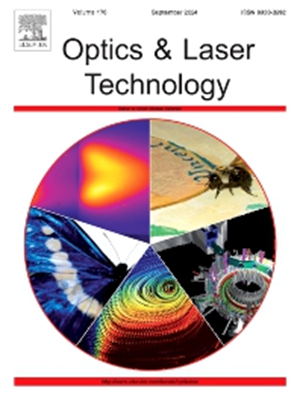Coherent supercontinuum generation by the high-order soliton molecules amplification
IF 4.6
2区 物理与天体物理
Q1 OPTICS
引用次数: 0
Abstract
We present an experimental investigation of the amplification of soliton molecules (SM) in an erbium-doped all-fiber amplifier. The amplification of a 10-pulse regime (with 509 fs pulse duration, 2.64 ps pulses separation, and low repetition rate Allan deviation of at a 1 s averaging interval of 10-hour free-running measurement), generated by an erbium-doped fiber ring laser mode-locked through nonlinear polarization evolution (NPE), achieved an average power of 152 mW for stable amplified soliton molecules (SM). This process resulted in high coupling states with the same number of pulses and spectrum broadening leading to coherent supercontinuum generation. A wide spectrum with a comb-teeth structure in the range [1400 nm – 1700 nm] was obtained without pulse fission (10 pulses remains coherently in time domain with increased pulse duration up to 1.129 ps and without changing in the time separation between pulses), achieved through precise amplification of the SM without the use of high-nonlinearity fibers (HNLFs), and with low relative intensity noise of 0.0108 % in the range of 10 kHz – 1 MHz. Additionally, we demonstrate the characteristics of amplified SM as a function of the number of pulses, which was varied by adjusting the pump power of the master oscillator. The number of solitons remained constant during extra-cavity amplification; however, the results for SM amplification with 3, 4, 5, 7, 9, and 10 pulses indicate tunability in both the average and peak power of the amplified pulses. These findings position soliton molecules as a novel tool for optical frequency comb spectroscopy and with spectrum broadening suitable for potential application in f-2f interferometry.
求助全文
约1分钟内获得全文
求助全文
来源期刊
CiteScore
8.50
自引率
10.00%
发文量
1060
审稿时长
3.4 months
期刊介绍:
Optics & Laser Technology aims to provide a vehicle for the publication of a broad range of high quality research and review papers in those fields of scientific and engineering research appertaining to the development and application of the technology of optics and lasers. Papers describing original work in these areas are submitted to rigorous refereeing prior to acceptance for publication.
The scope of Optics & Laser Technology encompasses, but is not restricted to, the following areas:
•development in all types of lasers
•developments in optoelectronic devices and photonics
•developments in new photonics and optical concepts
•developments in conventional optics, optical instruments and components
•techniques of optical metrology, including interferometry and optical fibre sensors
•LIDAR and other non-contact optical measurement techniques, including optical methods in heat and fluid flow
•applications of lasers to materials processing, optical NDT display (including holography) and optical communication
•research and development in the field of laser safety including studies of hazards resulting from the applications of lasers (laser safety, hazards of laser fume)
•developments in optical computing and optical information processing
•developments in new optical materials
•developments in new optical characterization methods and techniques
•developments in quantum optics
•developments in light assisted micro and nanofabrication methods and techniques
•developments in nanophotonics and biophotonics
•developments in imaging processing and systems

 求助内容:
求助内容: 应助结果提醒方式:
应助结果提醒方式:


